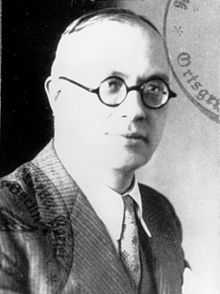Martin Luther (diplomat)
- For other people named Martin Luther see: Martin Luther (disambiguation).
| Martin Luther | |
|---|---|
 | |
| Nazi Reich Foreign Ministry Representative To The Wannsee Conference | |
| In office 20 January 1942 – 6 March 1942 (Two Meetings) | |
| Personal details | |
| Born | 16 December 1895 Berlin |
| Died | 13 May 1945 (aged 49) Berlin |
Martin Franz Julius Luther (German: [ˈmaɐ̯tiːn ˈlʊtɐ] (![]() ); 16 December 1895 – 13 May 1945) was an early member of the Nazi Party. He served as an advisor to Foreign Minister Joachim von Ribbentrop, first in the Dienststelle Ribbentrop ("Ribbentrop Bureau"), and later in the Auswärtiges Amt ("Foreign Office") as a diplomat when von Ribbentrop replaced Konstantin von Neurath. He is perhaps most remembered for having participated in the infamous Wannsee Conference, in which the Final Solution was planned. It was the 1947 discovery of Luther's copy of the minutes of the Wannsee Conference that first made the Allied powers aware that the conference had taken place, and more importantly, what its purpose was.
); 16 December 1895 – 13 May 1945) was an early member of the Nazi Party. He served as an advisor to Foreign Minister Joachim von Ribbentrop, first in the Dienststelle Ribbentrop ("Ribbentrop Bureau"), and later in the Auswärtiges Amt ("Foreign Office") as a diplomat when von Ribbentrop replaced Konstantin von Neurath. He is perhaps most remembered for having participated in the infamous Wannsee Conference, in which the Final Solution was planned. It was the 1947 discovery of Luther's copy of the minutes of the Wannsee Conference that first made the Allied powers aware that the conference had taken place, and more importantly, what its purpose was.
History
Luther ran a furniture removal and interior decorating business. He joined the NSDAP and SA on 1 March 1933. When Ribbentrop was sent to London as Ambassador in 1936, he hired Luther to move his furniture from Berlin and, later, to do the interior decorating of the new German Embassy in London. Luther was a master schemer and plotter, and these qualities led Ribbentrop to offer him a position in his own foreign policy organisation, the Ribbentrop Bureau. Luther accepted, and henceforward became one of Ribbentrop's favourite hatchet men.
In May 1940, he was appointed to the position of Foreign Ministry liaison to the SS. He represented the Foreign Ministry at the Wannsee Conference, which was convened by SS-Obergruppenführer Reinhard Heydrich in order to work out the details of the "Final Solution to the Jewish Question". At this conference, he voiced concern about the large-scale "resettlement" required throughout occupied Europe, which seemed to indicate that he did not fully understand what was being planned.
After January 1942, Luther's principal task was to persuade or pressure German satellites and allies to hand over their Jewish populations for deportation to the death camps, a job which he performed with considerable aplomb. Bizarrely enough, during this period Luther continued to work as an interior decorator for Ribbentrop's spouse, helping her with the design of her various houses, as well as her clothes. Luther resented having to work for Ribbentrop's wife, stating that she treated him like one of her household servants. This was the origin of the break between Luther and the Ribbentrops.
In 1943, with the aid of Franz Rademacher, he tried to supplant von Ribbentrop as Foreign Minister, but was thwarted and sent to Sachsenhausen concentration camp in 1944. He was freed by Soviet troops in May 1945, but died shortly after of a heart attack.
A year after his death, Luther's copy of the Wannsee Conference minutes was found by American investigators in the archives of the German Foreign Ministry. It is the only record of the conference that survived the war, and its discovery was the first time the Allies became aware of the meeting on 20 January 1942 and a subsequent follow up meeting on 6 March 1942.
Portrayals in fiction
- He played an integral part in Robert Harris's alternate history novel, Fatherland.
- In the 2001 HBO film Conspiracy he was played by Kevin McNally.
References
- Browning, Christopher (1978). The Final Solution and the German Foreign Office: A Study of Referat D III of Abteilung Deutschland, 1940-43. New York: Holmes & Meier.
|